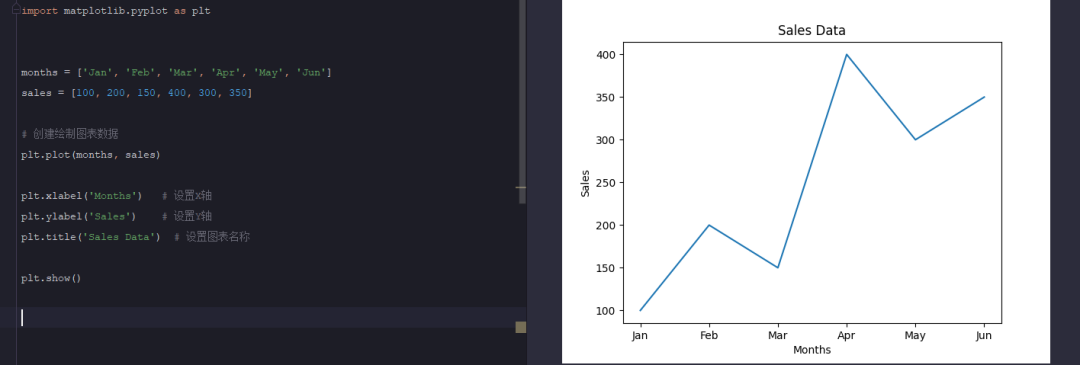聲明:由于本文的代碼大部分是參考書中的例子,所以不提供完整代碼,只提供示例片段,也就是只能看出某一部分用法,感興趣的需要在自己的數據上學習測試。
?
最開始,當然還是要導入我們需要的包:
# -*- coding=utf-8 -*-
from matplotlib import pyplot as plt
from sklearn.datasets import load_iris
import numpy as np
import itertools
1. 畫散點圖
畫散點圖用 plt.scatter(x,y)。畫連續曲線在下一個例子中可以看到,用到了 plt.plot(x,y)。
plt.xticks(loc,label) 可以自定義 x 軸刻度的顯示,第一個參數表示的是第二個參數 label 顯示的位置 loc。
plt.autoscale(tight=True) 可以自動調整圖像顯示的最佳化比例 。
plt.scatter(x,y)
plt.title("Web traffic")
plt.xlabel("Time")
plt.ylabel("Hits/hour")
plt.xticks([w*7*24 for w in range(10)],['week %i' %w for w in range(10)])
plt.autoscale(tight=True)
plt.grid()
##plt.show()
畫出散點圖如下:

2. 多項式擬合并畫出擬合曲線
## 多項式擬合
fp2 = np.polyfit(x,y,3)
f2 = np.poly1d(fp2)
fx = np.linspace(0,x[-1],1000)
plt.plot(fx,f2(fx),linewidth=4,color='g')
## f2.order: 函數的階數
plt.legend(["d=%i" % f2.order],loc="upper right")
plt.show()
效果圖:

3. 畫多個子圖
這里用到的是 sklearn 的 iris_dataset(鳶尾花數據集)。
此數據集包含四列,分別是鳶尾花的四個特征:
sepal length (cm)——花萼長度
sepal width (cm)——花萼寬度
petal length (cm)——花瓣長度
petal width (cm)——花瓣寬度
這里首先對數據進行一定的處理,主要就是對特征名稱進行兩兩排列組合,然后任兩個特征一個一個做 x 軸另一個做 y 軸進行畫圖。
# -*- coding=utf-8 -*-
from matplotlib import pyplot as plt
from sklearn.datasets import load_iris
import numpy as np
import itertools
data = load_iris()
#print(data.data)
#print(data.feature_names)
#print(data.target)
features = data['data']
feature_names = data['feature_names']
target = data['target']
labels = data['target_names'][data['target']]
print(data.data)
print(data.feature_names)
這里有一個排列組合參考代碼,最后是取出了兩兩組合的情況。
排列組合的結果是 feature_names_2 包含了排列組合的所有情況,它的每一個元素包含了一個排列組合的所有情況,比如第一個元素包含了所有單個元素排列組合的情況,第二個元素包含了所有的兩兩組合的情況......所以這里取出了第二個元素,也就是所有的兩兩組合的情況
feature_names_2 = []
#排列組合
for i in range(1,len(feature_names)+1):
iter = itertools.combinations(feature_names,i)
feature_names_2.append(list(iter))
print(len(feature_names_2[1]))
for i in feature_names_2[1]:
print(i)
下面是在 for 循環里畫多個子圖的方法。對我來說,這里需要學習的有不少。比如
for i,k in enumerate(feature_names_2[1]): 這一句老是記不住。
比如從列表中取出某元素所在的索引的方法:index1 = feature_names.index(k[0]),也即 index = list.index(element) 的形式。
比如 for 循環中畫子圖的方法:plt.subplot(2,3,1+i)
比如 for 循環的下面這用法:for t,marker,c in zip(range(3),">ox","rgb"):
plt.figure(1)
for i,k in enumerate(feature_names_2[1]):
index1 = feature_names.index(k[0])
index2 = feature_names.index(k[1])
plt.subplot(2,3,1+i)
for t,marker,c in zip(range(3),">ox","rgb"):
plt.scatter(features[target==t,index1],features[target==t,index2],marker=marker,c=c)
plt.xlabel(k[0])
plt.ylabel(k[1])
plt.xticks([])
plt.yticks([])
plt.autoscale()
plt.tight_layout()
plt.show()
這里的可視化效果如下:

4. 畫水平線和垂直線
比如在上面最后一幅圖中,找到了一種方法可以把三種鳶尾花分出來,這是我們需要畫出模型(一條直線)。這個時候怎么畫呢?
下面需要注意的就是 plt.vlines(x,y_min,y_max) 和 plt.hlines(y,x_min,x_max) 的用法。
plt.figure(2)
for t,marker,c in zip(range(3),">ox","rgb"):
plt.scatter(features[target==t,3],features[target==t,2],marker=marker,c=c)
plt.xlabel(feature_names[3])
plt.ylabel(feature_names[2])
# plt.xticks([])
# plt.yticks([])
plt.autoscale()
plt.vlines(1.6, 0, 8, colors = "c",linewidth=4,linestyles = "dashed")
plt.hlines(2.5, 0, 2.5, colors = "y",linewidth=4,linestyles = "dashed")
plt.show()
此時可視化效果如下:

5. 動態畫圖
plt.ion() 打開交互模式。plt.show() 不再阻塞程序運行。
注意 plt.axis() 的用法。
plt.axis([0, 100, 0, 1])
plt.ion()
for i in range(100):
y = np.random.random()
plt.autoscale()
plt.scatter(i, y)
plt.pause(0.01)
可視化效果:

 電子發燒友App
電子發燒友App















































評論